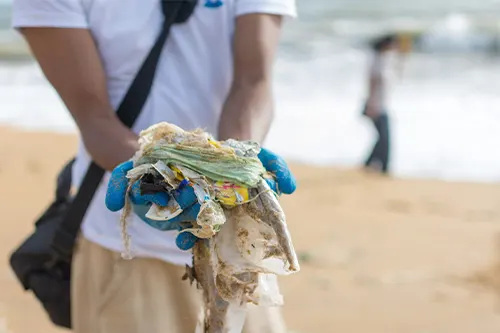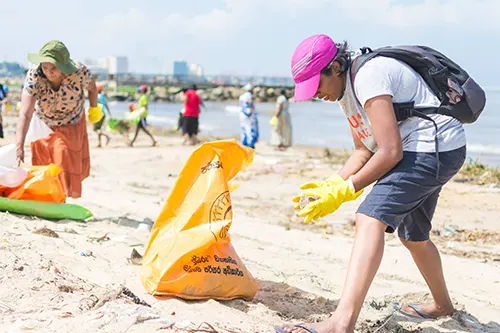Keeping our Beaches Clean
Our oceans are facing greater risks owing to increased amounts of waste and pollution such as accumulation of ‘single-use plastics’ and toxic chemicals.
 A beach area reflects the ocean’s devastation where the majority of the waste accumulated is from the ocean. 80% of the seabed in the western province of Sri Lanka’s is polluted while it is estimated that by 2050, plastic will outweigh fish in the ocean. 80% of marine trash comes from land-based sources. Since it is a man-made problem, it is entirely preventable, it is entirely preventable. This is by refusing single-use items, reducing waste, reusing items and recycling trash.
A beach area reflects the ocean’s devastation where the majority of the waste accumulated is from the ocean. 80% of the seabed in the western province of Sri Lanka’s is polluted while it is estimated that by 2050, plastic will outweigh fish in the ocean. 80% of marine trash comes from land-based sources. Since it is a man-made problem, it is entirely preventable, it is entirely preventable. This is by refusing single-use items, reducing waste, reusing items and recycling trash.
Volunteering to clean a beach is an excellent opportunity to witness the marine destruction caused. It also helps in building community cohesion, social interaction, community awareness, volunteering skills and directly impacts in protecting our marine environment.
By following this beach clean-up guide, individuals and organizations can conduct beach cleaning events in a proper and organized manner.
Organizations must take the initiative in inspiring, recognizing and appreciating the volunteers before, during and after conducting a beach cleaning event. It is also important to follow the beach cleaning guidelines, pre-site visiting, volunteer briefing prior to the event, provide necessities/resources and supervise volunteers while at site.
 Beach waste survey data is very important to be gathered, maintained and shared. Customize your own survey form and complete it while cleaning the beach or at the end. The cleaned waste must be recorded according to step four categories; based on the amount of bags or weight. Share your surveyed statistics with @pearlprotectors.
Beach waste survey data is very important to be gathered, maintained and shared. Customize your own survey form and complete it while cleaning the beach or at the end. The cleaned waste must be recorded according to step four categories; based on the amount of bags or weight. Share your surveyed statistics with @pearlprotectors.
Experts agree that the entire beach should be avoided after a major storm for at least 72 hours because of the potential risks to human health. Volunteers below the age of 16 must always be supervised.
Volunteers must follow a code-of-conduct where priority must be on professionalism, consideration of the surrounding, team building, being empathetic and follow local rules and regulations.
While beach cleaning is fun and interactive, it is also important to increase awareness while being inspired to protect the marine environment of Sri Lanka.
A Step by Step Guide
Allocate the required time
Aim for a minimum cleaning time range of two to four hours. Make sure you have adequate time to travel to and from the location as well.
Consider the weather
Avoid planning beach clean-ups during inclement weather or during rainstorms
Consider the time of day
Beach clean-ups are recommended during the morning or afternoon.
Consider other personal commitments
Focus and commit towards volunteering till the end rather than rushing.
Identify the area of cleaning
Calculate and define an area depending on the volunteers.
Consider the Geography
Avoid rough terrains and sewage outlets
Address all safety and security concerns at the start
Acquire necessary permission and inform authorities.
Be aware of local regulations and guidelines
Avoid private properties, red flagged areas, security zones, etc…
Have easy accessibility to the site
Ease of removing waste and exiting during any emergencies.
Consider the type of waste on site
Avoid areas with hazardous, chemical and sewage waste
Ensure that you are well resourced
Wear protective gear
Reusable rubber gloves, closed toed shoes or protective slippers
Use rice bags or jute gunny bags when cleaning
Avoid using plastic garbage bags or polythene bags
Wear comfortable attire
White or light-coloured attire is better than dark
Statistic Sheet
Score segregated waste collected based on weight and bags
Reusable water bottle
Staying hydrated is essential. Avoid any single use bottles
Wear a cap or hat
Protect yourself from the heat of the sun
Have a partner or volunteer in a team
Will help decrease exhaustion and increase the cleaning capabilities
Optional Tools
Garden rake, shovel, industrial gloves, mechanical grabber, extra collection bags, extra gloves
PET Bottles
Collected by @eco_friends_sl / @zerotrashlk
Flip-flops, slippers, sandals, and shoes
Collected by @flipyarn
Glass
Collected by @cleantech_lk
Styrofoam, sponge, polyurethane foams
Collected by @hantsgroupsl
Plastic waste (discarded fishing nets, plastic straws, plastic packaging, plastic wrappers, micro-plastic, plastic utensils, plastic bags, etc…)
Collected by @cleantech
Avoid collecting any waste which is biodegradable. These include; plant-based waste, paper, cloth, food, rusted metal, manure, and slaughterhouse waste
Be aware of any hazardous waste
DO NOT pick up any syringes, needles, any sharp objects, condoms, sanitary napkins, medical waste or anything that looks like it comes from a hospital. If collected, include them in a PET bottle and hand over to a hospital to dispose as medical waste.
If chemical substance is found, avoid collecting it.
Move the chemical substance away from human contact using an external tool.
Avoid touching sensitive parts of your body while the cleanup is progressing
Protect yourself from infections that can spread through touching your eyes, nose, and mouth when your hands are dirty.
Avoid venturing into the sea unless pre-planned
Respect the power of the sea. Sudden currents and unexpected dips on the seabed can be dangerous if not pre planned.
Constantly drink water and stay hydrated
It’s easy to forget to drink water but make sure to avoid dehydration.
Take a four minute rest for every 20 minutes of cleaning
Not only will this stop you from tiring out but will allow you to get a perspective of what you have achieved so far.
If dead marine animals are found report immediately on pearlprotectors.org
Make sure to report any dead marine animal that you find by filling out this form.
Talk to people and inspire them to join as volunteers
Encourage your friends, families and even strangers to take part and join as volunteers.
Spread the awareness of marine conservation
Share the importance of what you are doing with everyone you can.
Be responsible for the waste collected and of disposing
Take ownership of the waste you cleared and ensure that the right process of disposal is followed.
Avoid burning or burying any waste
Burning will add to the pollution and should not be encouraged or followed. Burying will also not ensure safety to other life forms.
Each item mentioned in step four needs to be provided to the correct recycler, upcycle centre or waste collection centre
Ensuring that the correct parties are provided with segmented waste will ensure that it is disposed of properly.
Share pictures of the waste collected. Inspire volunteerism
Pride yourself on your achievement, and if you have them, share some photos and videos. Every little piece of garbage cleared makes a massive difference.
Share the statistics report with The pearl Protectors
If possible, we encourage sharing your statistics with us. It will help us identify which area needs a more focussed effort and the frequency.
